Endings are hard. For every truly great series finale, there’s one terrible one… and about eight perfectly okay ones. Every finale is expected to tie up its own stories, but “Life, Itself” has the added pressure of wrapping up the first series of the modern Trek era.
“Life, Itself” is not a great finale, but it’s not a terrible one either. It’s fine — somewhere in the middle of that eight out of ten — and if they had just let it be done when it was done it might have been near the top. Star Trek: Discovery has been a divisive show, but also an incredibly important one, and awareness of its importance and its legacy might explain why it made some of the choices it did.
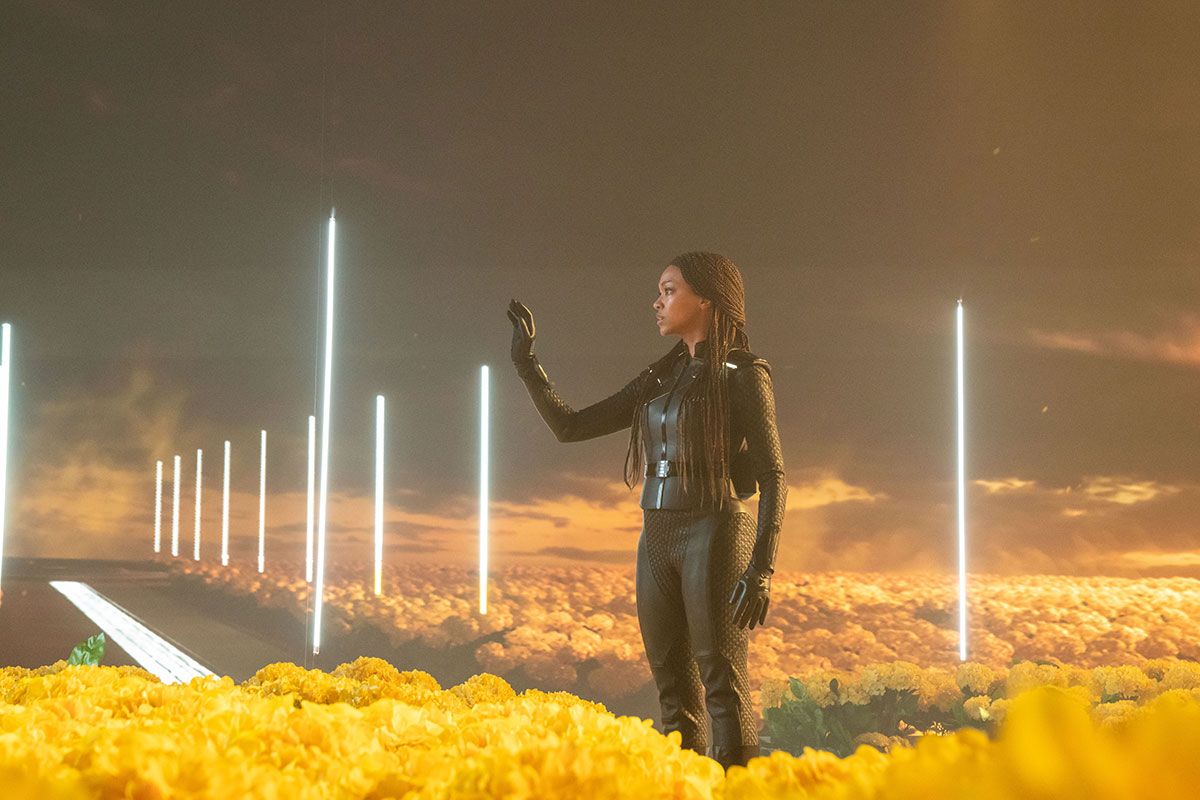
We begin right where we left off in “Lagrange Point,” as Captain Burnham (Sonequa Martin Green) emerges into the Progenitor’s realm: a seemingly endless space filled with floating walkways that reach to the horizons and windows leading to other worlds.
It’s sleek and high-tech, but there are natural elements as well. It’s very cool looking and well designed, and aesthetically and mechanically it immediately feels like a videogame. I don’t say this as a criticism — I spend a lot of time playing and enjoying video games — just that it’s where my mind went.
Burnham’s fights with one of the Breen who first entered the portal (and later Moll), using wind-gust-enabled super jumps and the strange gravity of the place only reinforced that impression for me. It’s the first time in my many decades of watching Star Trek that I’ve thought, “This is a video game!” It’s after this elaborate fight that takes Burnham and Moll (Eve Harlow) from the “lobby” through to other worlds and back again that the two finally settle on a truce — if they’re focused on fighting each other, neither of them are ever going to get out of here, much less find and activate the Progenitors’ technology.

Outside the portal, Discovery watches as the Breen dreadnought quickly recovers from its skewering to be a threat again, both the ship itself and also the swarm of small fighters it launches.
Commander Rayner (Callum Keith Rennie) wants to be able do it all — stay near the portal, keep the dreadnought away from the portal, keep those fighters at bay, try to communicate with and/or recover Burnham, and stay alive and in the area for when Tahal arrives in a dreadnought of her own — but realizes that he’s got one too many things on his plate. He’s going to need to drop one if he wants to keep everyone alive.
With the opportunity to kill multiple fighters with one detonated plasma cloud too good to pass up, Rayner decides he can’t afford to keep Discovery near the portal. Book (David Ajala) and Culber (Wilson Cruz) of all people — who insists against Stamets’ objections that he needs to come along — stay behind in a shuttle to guard the Progenitor portal.
Meanwhile, Saru (Doug Jones) and Nhan (Rachael Ancheril) are doing their part to defuse the situation as well. Talking to Tahal while he heads to the black holes at high warp, Saru offers her an exclusive trade route in exchange for her turning back from Ruhn’s dreadnought. When she declines, Saru goes in for the kill, calling her a coward and telling her he knows about her secret bases in that same stretch of space. If she doesn’t turn back now the Federation will destroy those bases and will start a war with the Breen.
He’s later described as ‘Action Saru’ again, but really this is Predator Saru. “Look into my eyes and tell me I’m not serious.” Oh he is, and she turns away, leaving just a small cloaked (but detected) scout ship in the area.
Saru’s shuttle, and Book’s as well, saw the NX-02’s distractingly-flashy bridge lighting and said “Hold my Romulan ale.” I already wasn’t a fan of that shuttle design (why is it so empty and cavernous inside?) but now that they’ve added a huge panel of pulsating lights that sits right in the middle of the frame I really don’t care for it.
Combine this with director Olatunde Osunsanmi’s decision to film much of Saru’s scene through a constantly moving sea of flashes and streaks and what looks like rippled, warped plexiglass, and I found parts of the sequence to be visually unpleasant.
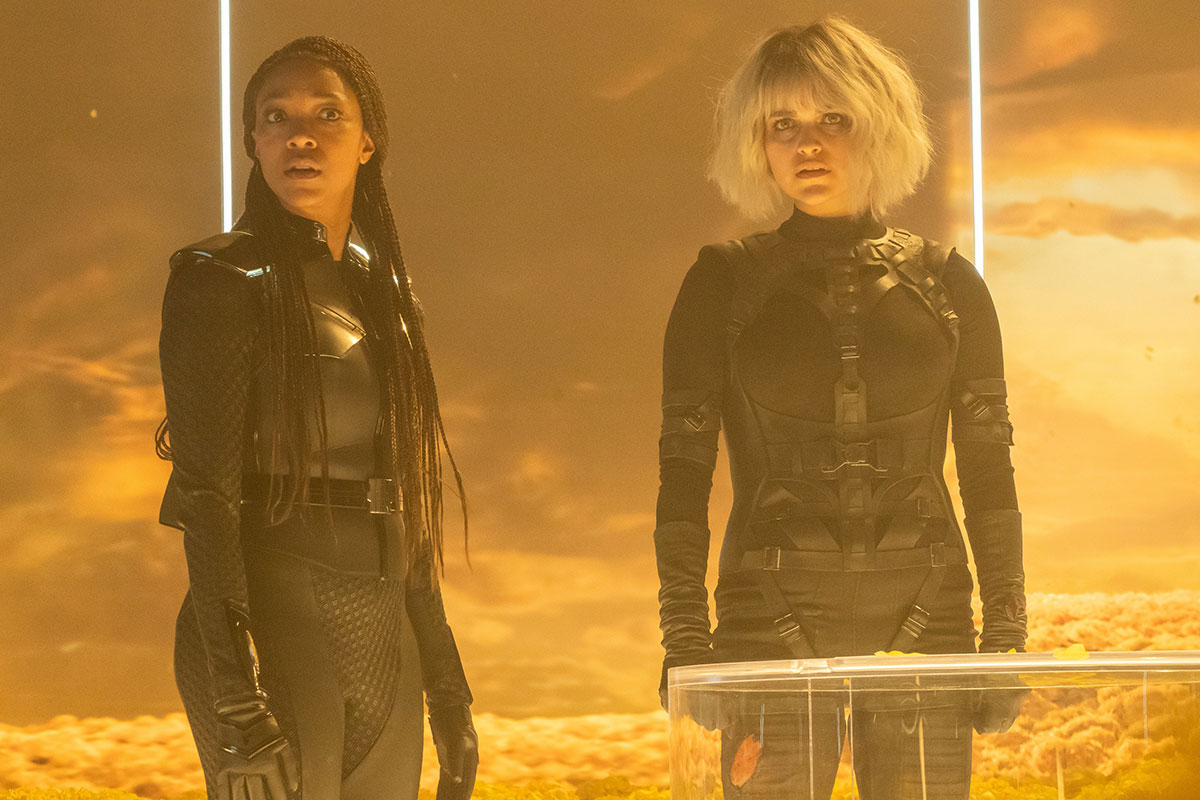
Back in the portal, Burnham and Moll have finally found the Progenitors’ technology. The console is simple, just a surface with nine moveable triangles on it. Burnham shares the final clue (or riddle, really) with Moll, that they need to make the one between the many. Moll interprets this one way, but Burnham’s not so sure. Not wanting to wait any longer, Moll knocks Burnham out and gets to work at the controls. Oops, her solution is wrong, and things start to hit the fan.
I understand how and why the five scientists created tests of ethical and moral fortitude to safeguard the Progenitors’ technology — and ensure that only someone trustworthy would be able to find and access it — but the fact that they added one last obstacle that entirely hinges on just how literally someone is going to be with an abstract riddle is a little strange. Moll’s solution, to make a solid triangle with the pieces, is perfectly reasonable; any “chosen one” of otherwise impeccable character who had passed all the other tests could easily have made the same mistake without any bearing on their worthiness to wield Excalibur, as it were.
I know we’re supposed to see that Moll is being punished for her impatience, but really it seems like a flip of the coin whether the “good” person is or isn’t going to pick the right solution to an open-ended riddle. “Ah, so close, we think you’re great… but it’s actually a young woman instead of an old crone so we’re going to have to kill you now.”
Moll’s incorrect usage of the console kicks it into life, but in what appears to be an uncontrolled way. Outside in space, the portal starts drawing energy (and mass) from one of the black holes, pulling it closer and closer to the event horizon and threatening to destabilize the system.
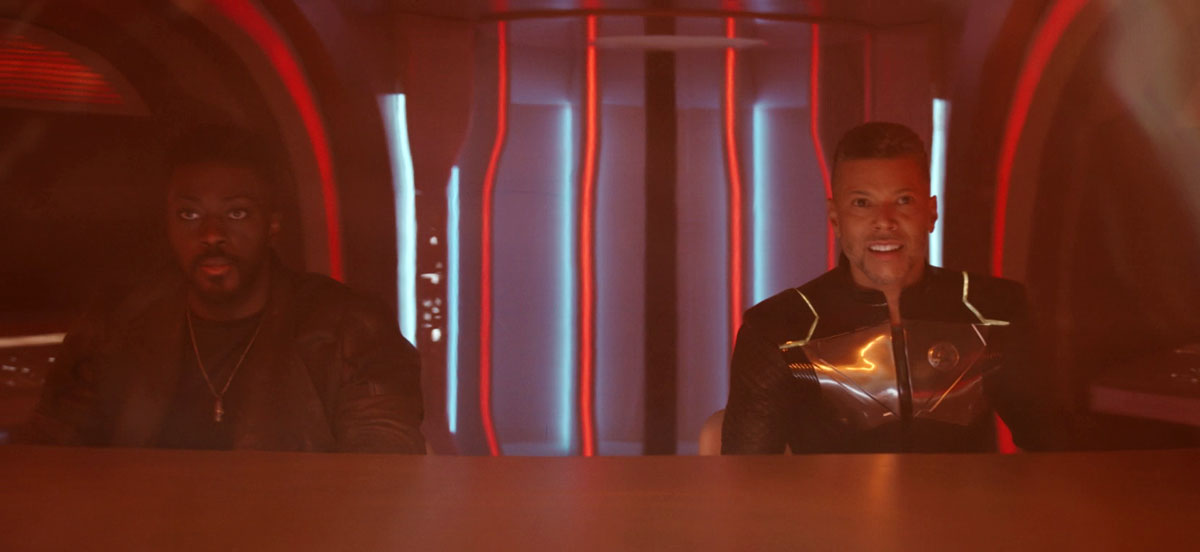
From his shuttle, Book struggles to get a tractor lock on the portal, but Culber comes to the unlikely rescue. In a moment of epiphany which seems almost magical, he pulls a precise harmonic frequency out of the ether and it works, allowing the shuttle to hold the portal in place and stop its fall.
Was this a moment of divine inspiration? A glimpse of the universe telling Culber its secrets? Well, no, it’s actually just a surfaced memory from his Trill zhian’tara experience with Jinaal, who’d found himself in the same scenario 800 years prior. While this is a perfectly good, logical explanation for Culber’s actions in the moment, is that really it for his larger story arc? Has Culber been dipping his toe into existential questions of religious faith all season because of one nagging Trill memory, or is there more to it?
It feels as if the show wanted something bigger and grander and more mystical to be happening, and then remembered at the last minute that this is Star Trek and we don’t do that here. If this was a plotline I cared more about I would be disappointed with its conclusion, but as it is my response is just a big “Okay.”
Even with the Breen fighters destroyed, the dreadnought — and Tahal’s lingering scout ship — are still a big problem, so Rayner comes up with an equally big solution. Separating Discovery’s saucer and the drive sections and maneuvering them into position on either side of the dreadnought, he essentially uses the ship a huge pattern enhancer, “beaming” the dreadnought to the galactic barrier by initiating a spore jump between Discovery’s two sections. It’s crazy, it looks cool, and it works.
It’s also a harbinger of how Discovery is going to address the other of its two big storylines: simply erasing it from the board.
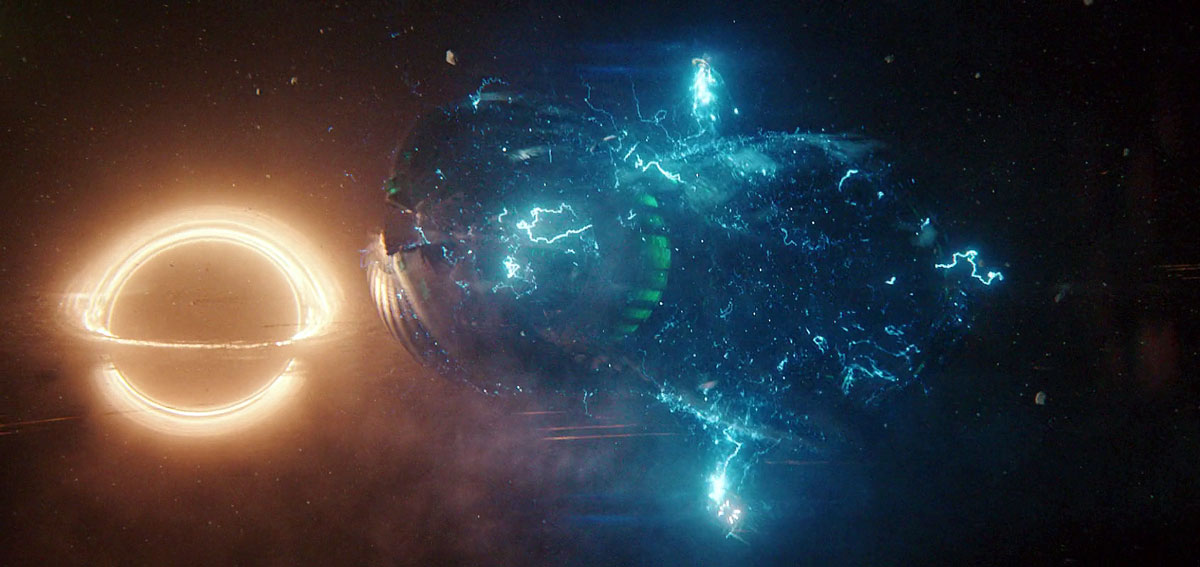
Inside the portal, Burnham regains consciousness, removes Moll from where she’s been stuck to the console, and comes up with the correct configuration of the little triangles (negative space triangle instead of Moll’s positive space one)… and a Progenitor (Somkele Iyamah-Idhalama) appears.
This is it, the moment the entire season has been leading up to, and it is suitably profound. We watch Burnham have a conversation with someone who’s been dead for four billion years about the nature of life itself, and the revelation that the Progenitors didn’t create this technology — but instead found it just the way Burnham has — hints at the existence of (a) God and also makes me want to play through the Mass Effect trilogy again.
There’s a wrinkle in all of this, though: according to the Progenitor, for completing the quest to access the technology, Burnham is the person who can it. That’s a lot. It’s, understandably, too much. She doesn’t have to use it now, she can come back later, but she cannot, it seems, hand this off to someone else within the Federation. It cannot be a collective venture, it is power for Burnham to wield alone.
And so, she decides to destroy it.
Her reasoning for not wanting to use the technology is valid — and strongly Star Trek. We already have infinite diversity in infinite combinations, and thus we don’t have need for the power of creation. There’s nothing that needs to be added. That works for me as an overarching explanation for why Burnham doesn’t start spinning up new planets for fun.
We know from the Progenitor that the technology can’t really bring people back from the dead — sorry L’ak! — but maybe it can cure disease? Solve any lingering scarcity problems? Something else noble and positive and exhilarating? As Stamets (Anthony Rapp) excitedly announces, it represents the most significant scientific discovery of their lifetimes.
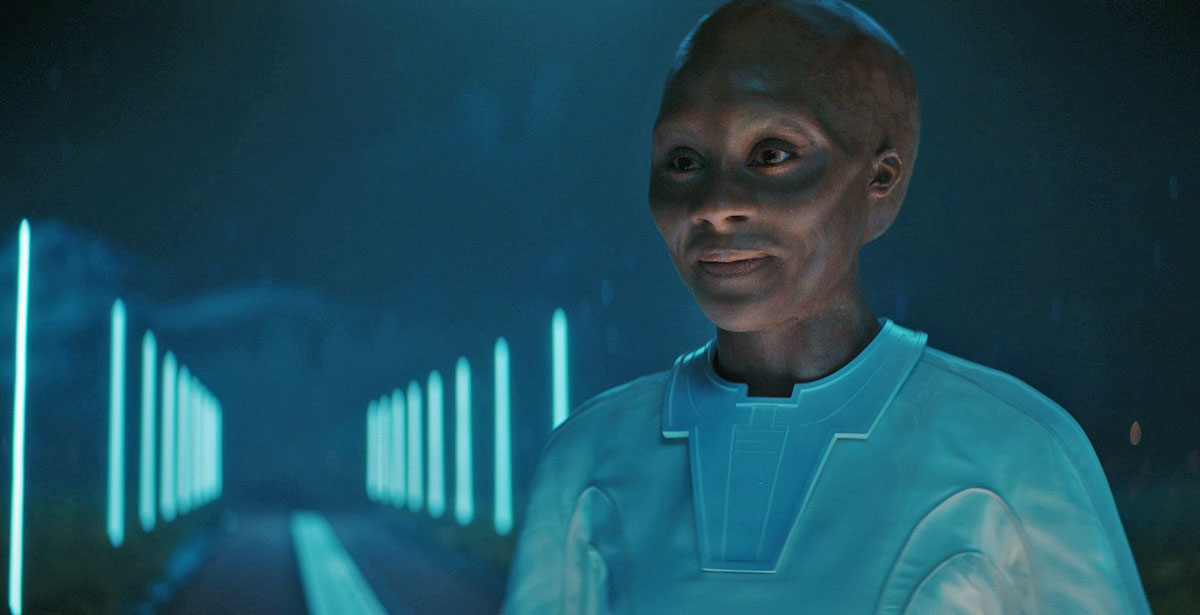
From a storytelling perspective, the decision not to use — and in this case going even further and deciding to destroy — the Progenitors’ technology is kind of the only choice they have. If the technology is really as powerful as it seems, it comes with the thorny side affect of either solving all plots before they exist or making all plots about itself. It’s not uncommon for television shows to introduce notably powerful characters or objects and then, once their immediate dramatic purpose is fulfilled, de-power or defuse them.
Sending the spore drive into the 32nd century where it can’t “bother” any of the rest of Star Trek’s long history of traditional warp drive is a perfect example of doing just that. But Stamets is also right in his disappointment, this is a scientifically unsatisfying conclusion and one that, the more I think about it, becomes a narratively unsatisfying one as well.
What are we doing here narratively if, after all the effort to get there (both in-universe but also in the crafting of the story itself) we end up at “Eh, never mind!” after 30 seconds of thought? A story is much more than its ending, but if, as this one was, it’s a story predicated on solving a puzzle and finding an answer, it does need a meaningful conclusion of some sort to be satisfying.
If the presence of the Progenitors’ technology was really such a problem for the story, maybe the writers should have chosen a different puzzle to solve in the first place. Instead, it seems as if Discovery is saying that yes, all jokes aside, the enormous godlike power and incredible scientific breakthroughs really are the friends we made along the way.
This is not the first time Star Trek has shown its characters, who are otherwise on a mission of exploration and the pursuit of knowledge, decide to turn away from that knowledge because gaining it is simply too dangerous. Captain Janeway does just that in “The Omega Directive,” stating that it would be “arrogant” and “irresponsible” to “risk half the quadrant to satisfy [their] curiosity” about the Omega molecule, the most powerful substance known to exist at the time.
But that was one installment of episodic television, not the conclusion to a highly serialized season-long arc, and the Omega molecule remains in existence as something that can be studied at a later date. Not to mention, the central purpose of the story is the discussion of scientific ethics. It’s not an afterthought, it’s front and center and characters spend time debating it.
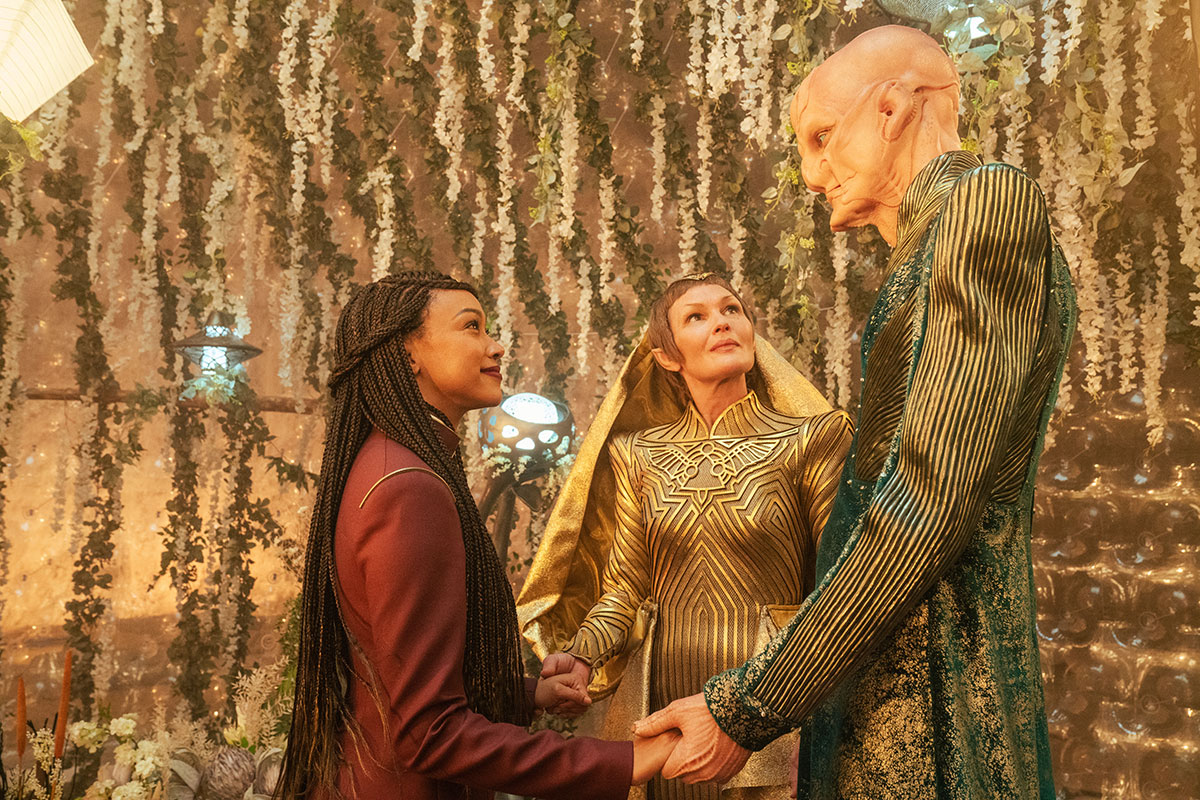
The Breen have been dispatched with, the Progenitors’ technology is gone, Moll is in custody, and the Red Directive is over. Things are settling back down, so it’s time now for the epilogue, tying things up for our characters and the series as a whole.
And then it turns out that Kovich (David Cronenberg) is actually Daniels, the futuristic temporal agent who visited Captain Archer throughout the four seasons of Star Trek: Enterprise! I never thought we’d hear about this guy ever again! His time-traveling ways explain a lot about his collection of era-spanning relics, his knowledge of centuries of Starfleet history, and his love of black outfits. (I asked for a bit more background to flesh out Kovich, and the Discovery writing team certainly delivered, dang.)
Several weeks later, Saru and T’Rina (Tara Rosling) are having lovely beachside wedding. Saru’s wedding attire is gorgeous, T’Rina’s is suitably bizarre — Vulcan’s are, for all their claims of logic, big fans of “more is more” when it comes to women’s fashion and we love them for it — and everyone’s in a good mood at the reception discussing their future plans. It sounds like Rayner (who survived, thank you!) is getting roped into a mentorship role at Starfleet Academy, and Burnham and Book are officially back together.
They talk of the future and literally walk off into the sunset together as they head toward whatever the next mission brings. The end… wait, that wasn’t the epilogue? There’s more? Why is there more? That was a perfect ending!

ONE LAST DANCE
The show jumps decades into the future, as we find a grey-haired Burnham and Book living a semi-retired life on the red-forested planet first visited back in “That Hope is You, Part 1.” Book has planted the last bit of Kweijanian World Root, Burnham is good at mending fences from interloping space deer… and then their grown son, a Starfleet captain, arrives to ferry Admiral Burnham to another Red Directive mission.
I’ll be blunt, I really don’t think show needed this epilogue. It was fine — nothing that happened was terrible — but it seemed completely unnecessary for the episode, the season, and the series as a whole. Watching the pair walk down the beach wondering what the future holds would have been a perfectly satisfying ending, leaving viewers with the hint that the exploration of the galaxy will go on, and that our characters will be the ones doing it, but without creating an unrealized cliffhanger.
Instead, we get a 20-minute setup for 2018’s “Calypso.” Really? The Short Trek that had already been given a perfectly satisfying nod earlier in the season when Zora asked if seeing Burnham and Rayner in the disastrous future was another dream — not to mention that many viewers around the world never even saw “Calypso” thanks to the limited Paramount+ distribution at the time, and minimal DVD release outside of North America.
Yes, there is more to the epilogue than that, but none of what we see is particularly unexpected, nor does it really tie up any loose ends. Burnham and Book live happily ever after? That was implied by them walking away together on the beach, thanks. Tilly (Mary Wiseman) teaches at the Academy still, decades later? Okay cool. Starfleet continues to cycle through new uniforms? Got it.
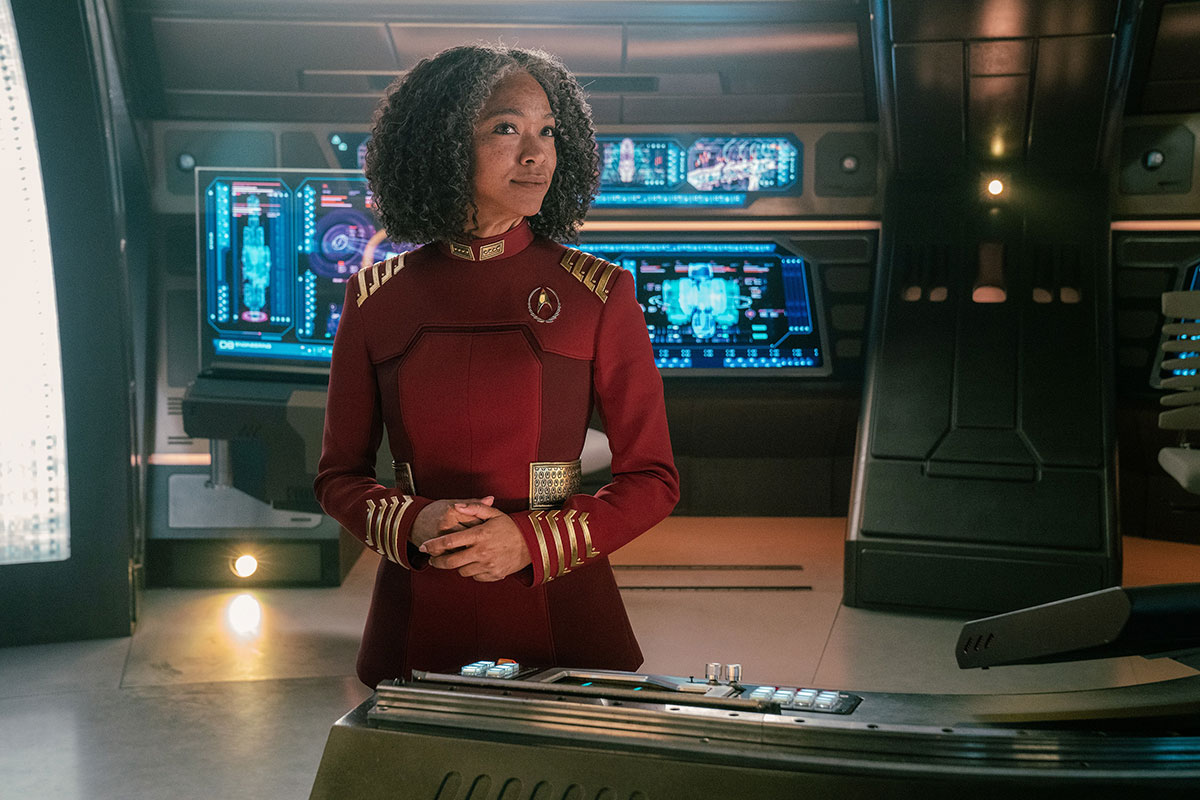
Burnham sits in the captain’s chair one last time to send Zora (Annabelle Wallis) and an un-refitted (antefitted?) Discovery off to sit somewhere so an 18-minute Short Trek from six years ago can occur, she drifts off into memories of her time aboard Discovery — and then shifts into a recollection of the crew that has the unfortunate feel of someone with dementia recalling people they used to know, but can’t quite remember the context for anymore.
It’s clear that this was not a memory of an actual occurrence, but instead Burnham’s mind lining up her former crew for one last mental goodbye, everyone laughing at jokes that no one’s told, bathed in glowy golden light, sharing hugs that don’t feel rooted in any real event. The whole thing goes on far too long and feels incredibly strange.
Burnham just talked with Tilly last week, why is she remembering their younger selves saying goodbye to one another? Is Discovery, the ship, being put out to pasture, or is Burnham?
OBSERVATION LOUNGE
- Fan-predicted things that did NOT happen this episode: none of the notable Discovery characters were killed, L’ak was not revived, and Book did not use the Progenitor’s technology to restore the Kwejian homeworld.
- This episode’s opening credit sequence includes elements from all four prior seasons of the show. A spacesuit helmet, Klingon weaponry, and an Original Series communicator represents Season 1; the Red Angel suit, the Enterprise captain’s chair, the transporter room animation and the original Starfleet delta emblem represent Season 2; Book’s ship represents Season 3; the Zora voice modulation graphic represents Season 4.
- Those portable pattern buffers sure are handy. Phasers, dermal regenerators, ham sandwiches — something for every situation!
- L’ak’s body makes an appearance, but actor Elias Toufexis did not actually return to Toronto for this episode, he revealed on social media.
- Culber gets a nice little McCoy homage with his “I’m a doctor, not a physicist” line.
- Nhan tells Saru, “Remind me to never play you in Ferengi rummy,” a game never previously mentioned in Trek.
- Stamets, Tilly and Adira (Blu del Barrio) find a way to quantum entangle the spore drive’s magic mushrooms, split the ship in two, and surround the Breen dreadnaught to jump it away from the dual singularities. Federation starships really do move at the speed of plot!
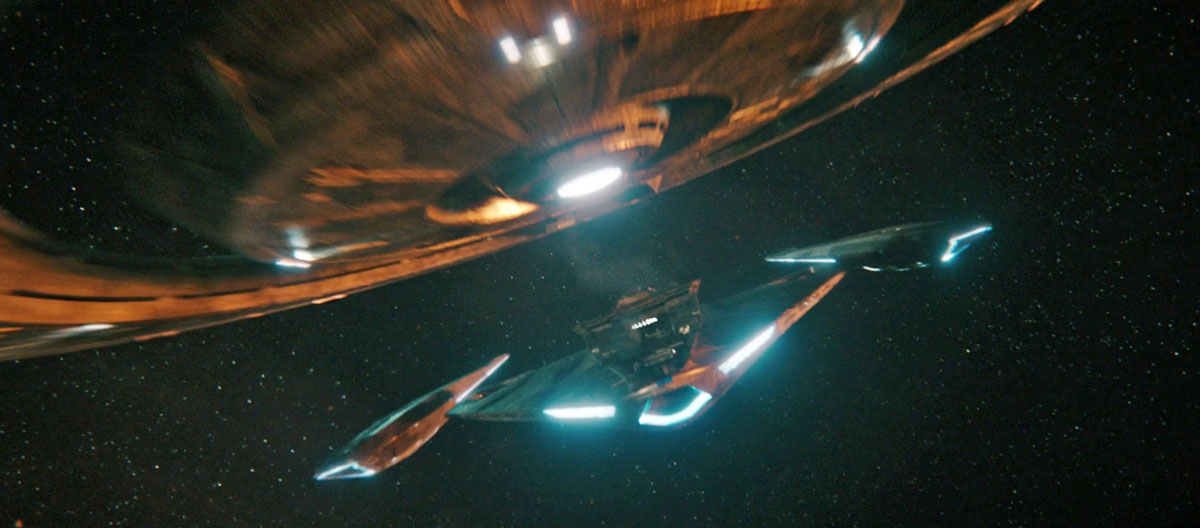
- Discovery separates its saucer and secondary hull for the first and only time in the series. (I don’t think we even knew the ship was capable of separation!)
- Force-jumping the Breen dreadnaught was ridiculous, but man did it look cool!
- When the Progenitor gives Burnham a taste of the technology’s power, she sees many past versions of herself: as a young girl, in her Season 1-2 uniform and hairstyle, wearing her yellow Starfleet prison jumpsuit from “Context Is for Kings,” and her Season 3 courier look.
- A reversed clip from Season 1’s “Will You Take My Hand?” is used in the Progenitor sequence — specifically the pullback from 23rd century Paris into Earth orbit, showing Spacedock under construction.
- It seems like the Discovery writing team seemed to have completely forgotten that Adira Tal hosts a Trill symbiont, with the many lifetimes of knowledge and experience that come with a joining. “When did you get so wise?” Stamets asks. Um, when they got a Trill symbiont two seasons ago, people!
- Familiar Star Trek items seen in Kovich’s office include a Terran Empire dagger, a TNG Season 1 “dustbuster” phaser, a bottle of Chateau Picard wine (vintage 2249), and a VISOR like the one worn by Geordi La Forge.
- Agent Daniels’ last appearance — prior to Season 3’s “Die Trying,” where we first
met Kovich — was the 2004 Star Trek: Enterprise episode “Storm Front, Part 2.”
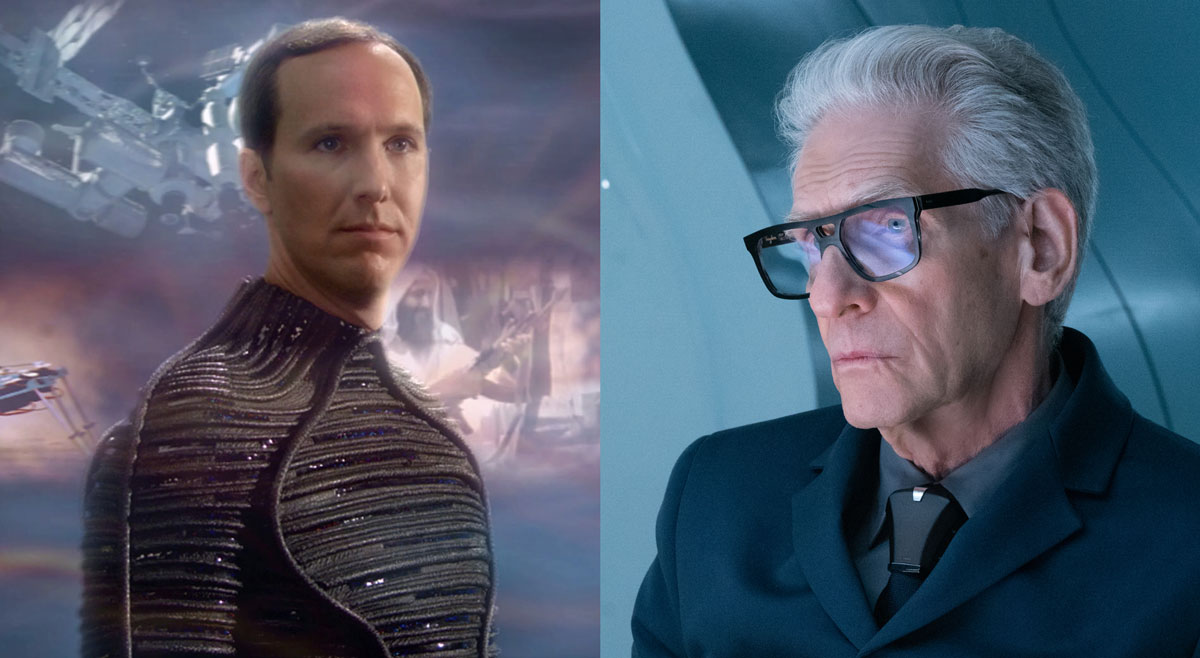
- I’m happy for T’Rina, but I did NOT love her wedding hair — yikes! I don’t know if her wig was slipping back under the weight of the headdress or if they just decided to give her a new haircut, but man those bangs were severe.
- Book mentions that he encountered a group of Talaxian pirates on the way to Saru and T’Rina’s wedding.
- The Starfleet officer who notifies Admiral Burnham that her shuttle is about to land
is voiced by Star Trek: Discovery showrunner Michelle Paradise. - The space deer outside of Burnham’s fence is named Alice, named for the main character of Burnham’s favorite childhood book.
- The 33rd century coda introduces yet another new Starfleet uniform design, complete with rank pips under the wearer’s chin (uncomfortable when looking down, no doubt), upside-down trapezoids on the arms, and one more Starfleet combadge redesign. An Admiral’s badge can even initiate an entire costume change, apparently!
- Captain Leto Burnham (Sawandi Wilson) is named for Book’s nephew Leto, who perished when Kwejian was destroyed in Season 4.
- Leto’s next mission is to the planet Crepuscula, which is the desert world where Burnham and Captain Georgiou were visiting in the opening moments of “The Vulcan Hello.”
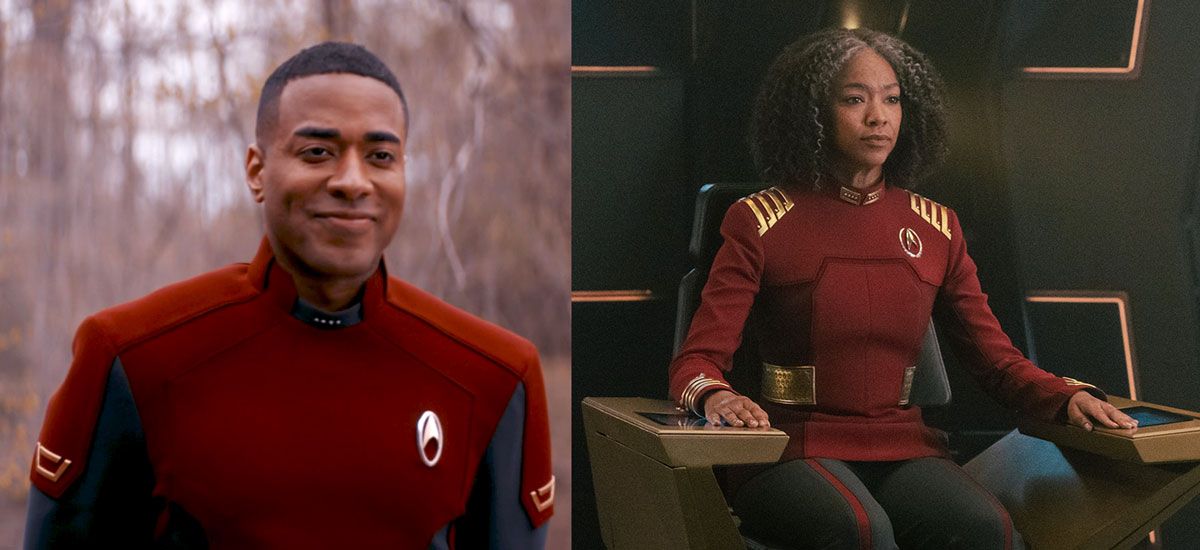
- Admiral Vance remains on active duty in the 33rd century, and Tilly is the longest-serving Starfleet Academy instructor in history. (Gee, I wonder if she’ll be in the Starfleet Academy series? Hmmmmm!)
- The USS Discovery’s physical arrangement is fully reverted to its original configuration — including the elimination of programmable matter and the “-A” designation on the outer hull, and restoration of the original command chair control panels — to align with the continuity of “Calypso,” which was filmed between Seasons 1 and 2.
- It seems kind of cruel to leave Zora alone for 1,000 years just to wait for Craft, right? Like, she’s a computer but she’s still a sentient being!
- Due to scheduling conflicts, Wilson Cruz was not available when the final ‘crew reunion’ on the Discovery bridge was filmed in 2023. Culber is represented by a stand-in during wide shots and a digital composite of Cruz from archival footage in his close-up — with his white uniform CGI’d in place.
- Detmer (Emily Coutts) and Owosekun (Oyin Oladejo) both say the word “happy” when we see them during the farewell montage. Are they happy… together???
- It may have taken five seasons and 900+ years, but as we see Discovery fly out to complete its last mission, somebody FINALLY remembered to shut the cargo bay door.
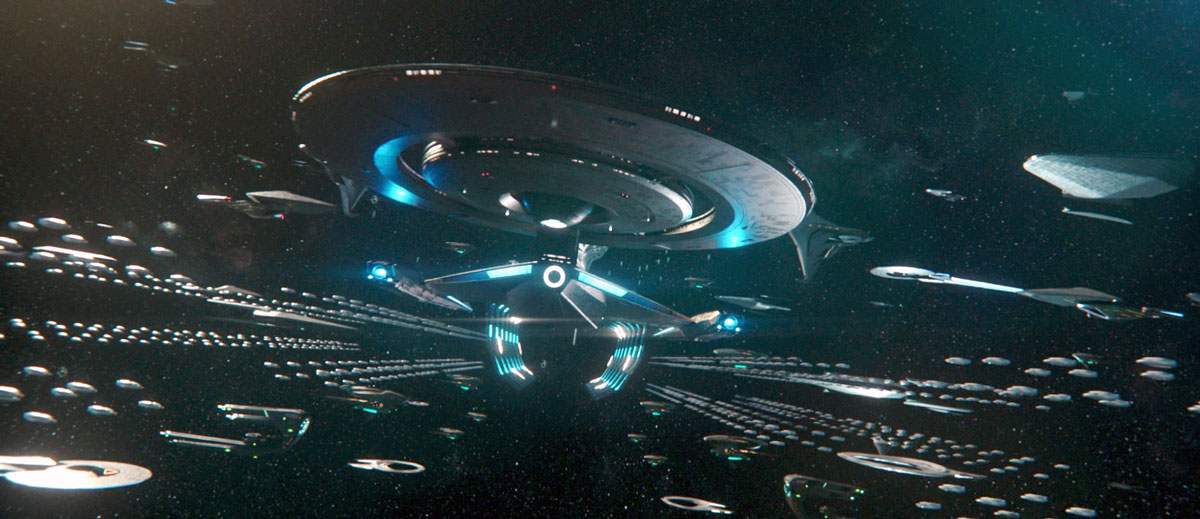
Discovery ushered in the modern era of Star Trek, something I truly never would have thought possible before it was announced back in 2015. I simply didn’t think there would ever be any new Star Trek after Enterprise’s fourth season came to an end in 2005.
I am so grateful for Discovery, not only for opening the door to so much new Trek — but also for bringing so many new fans into the fold. I know so many people in my personal life who started with Discovery and have gone on to watch and love everything else Star Trek as well. That’s huge, and Discovery did that.
Despite my personal quibbles with elements of “Life, Itself”, it feels like the right finale for Discovery — an episode that only this series would build towards and do. Lest anyone think I’m giving a backhanded compliment here, I’m not.
“Life, Itself” is the show that Star Trek: Discovery set out to be, unapologetically, and how great is it that it got the opportunity to realize itself?
![]()
Star Trek: Discovery may be over, but later this year we’ll be back with episodic reviews of Star Trek: Lower Decks and Star Trek: Prodigy when their next seasons debut.
